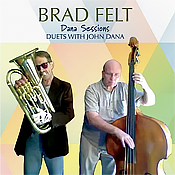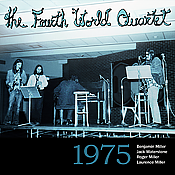Recent Recording by Area Artists
This month we look at a quartet of releases that well exemplifies the bold innovative music making that continues to enrich the long-standing Detroit tradition, from homage to the past to forward looking experimentation and ending with a hitherto unpublished classic.
An album of euphonium and string bass duets is surely a rarity in jazz, if not unique, and this is exactly what is offered on Brad Felt, Dana Sessions: Duets with John Dana (DartBkef Records, DBR001), recorded in 2010, just before Felt left us, as did Dana seven years later, now prepared for release by Felt’s son Brad. The scaled down duo context allows us to hear both musicians with clarity, reminding us once again of their importance on the Detroit area jazz scene and just how much they are missed, but also of their universal artistic merit. The tracks on this album, selected from home studio recordings, consist of standards, Charlie Parker tunes, and two Felt compositions, “You Walked Away” and “Sometime in the Fall.”
This is modern post-bop jazz played with relaxed precision, with a devoted sense of melody and harmony, and with a love for the modern jazz tradition. The tunes are well chosen for variety of tempo and mood and the musicianship is superb with intuitive interaction and precise pitch. Dana for the most part walks in a traditional manner, but his way of outlining the changes and comfortable rhythmic approach obviate any need for piano or drums, with ample space for solos. Felt, always a garrulous improviser, is at ease here; developing long lines and employing the full extent of modern jazz language but also demonstrating his uncanny command of the euphonium, an instrument rarely encountered in jazz solos. His broad range of articulations, attacks, and sonic command allow him to play with deep expressiveness, be it on up-tempo numbers such as the opening “Inner Urge,” or on ballads such as “You Are Too Beautiful,” or “I Wish I Knew.”
Throughout the thirteen-song recital Felt and Dana offer a wonderful concert of music that makes us miss them ever the more.
Mark Lipson (a close friend and admirer of Brad Felt) and the Detroit Composers Collective (DCM) has released Realism: Music of Mark Lipson, Ken Cox and Brad Felt (DCC Records 0101), featuring two groups made up of the top players in the SEMJA area: Dwight Adams, trumpet; Andrew Bishop, tenor saxophone; Cliff Monear, piano; Miles Brown, bass; Jesse Kramer, drums (Tracks 1, 5, 8 by Lipson); Dwight Adams, trumpet; Rafael Statin, flute, tenor saxophone; Terry Kimura, trombone; Michael Malis, piano/keyboards; Jeff Pedraz, bass; Sean Dobbins, drums; Pepe Espinosa, percussion (tracks 2–4, 6–7, one by Lipson and the Cox and Felt tunes).
Lipson created the DCM to preserve and keep in focus the composers of the Detroit jazz tradition and here he utilizes two different groups, focusing on compositions by Cox and Felt, setting aside his percussion skills to assume the role of composer/arranger of his own works, acting as the producer of the project. The slightly larger combo with percussionist Espinoza performs on two Latin-tinged Cox tunes, “Cuernavaca” and “Samba de Romance,” which appeared on Duet at Kerrytown (with Donald Walden) and Clap, Clap! The Joyful Noise, respectively. Both are lighthearted tunes, featuring Statin’s melodic flute and other fine solos. The same group digs into the two Felt compositions, “Existentialism” and “P.J. Lids,” likewise with south-of-the-border rhythmic influence, but more bite. The first of these opens with a high flying, riotously expressive solo by Statin, which segues nicely into a calmer statement by Adams, and then moves into a drum/percussion duet. On the second, which features more ensemble playing and backgrounds, Statin and Adams again solo with great passion.
Of the four compositions by Lipson, only “Tony’s Trip” utilizes the larger group and Latin rhythms. Here, Kimura’s blues-tinged bop trombone has an opportunity to shine, followed by Statin’s tenor in a more controlled but no less expressive outing that leads once again to the percussionists having their say. Lipson’s writing for the smaller group provides solid vehicles for improvisation, invoking a post-bop Blue Note kind of groove. On the opening track, “The Masters” Bishop absolutely dazzles with a seemingly off-hand solo that encapsulates his mastery of the full potential of the tenor sax in compressed form. The more impressionistic “Realism” begins with the rhythm section in a more modernistic manner, leading once again to Bishop, this time in fast-fingered full flight, with varied rhythmic articulation, as if Paul Gonsalves came back to life in an avant transformation. Adams shines as he does throughout, but it is the collective interaction of the quintet that is now dominant.
The first release by Lipson’s DCC offers a well-balanced homage to the masters, reworked for younger generations of artists who well demonstrate the Detroit veneration of tradition that is not static, but keeps evolving with the times.
Baritone saxophonist Kaleigh Wilder belongs to the latest generation of improvisers who are enriching the Detroit artistic legacy. Originally from Indiana, she came to Michigan to study music at the University of Michigan, where she focused on the baritone saxophone, and decided to stay after graduation, working as a freelancer in the Detroit area. She has just released a duo album, Placemaking, on which her low sax is joined by the drums and percussion of Everett Reid. The two have been practicing and performing together for some time and this is reflected in the tight synergy they achieve on eight tracks, one of which is an alternate take. Two of these were penned by Wilder, while the rest were completely improvised.
A saxophone/drum duo is a difficult proposition, but as a recital the album is well paced, displaying an impressive variety of spirit, mood, and instrumental techniques that work together to keep a listener’s attention. Much of it is soft and introspective, none more so than the aptly named improvised “Contemplation,” played by Wilder alone, which begins with her on gongs and then settles in softly into solo baritone that slowly develops from barely audible long tones into more visceral, bluesy vocalizations, getting down, before returning to longer tones, this time ominous, hardnosed, and multiphonic, signing off more softly. Wilder has a virtuoso control of her instrument, but she never wastes notes; her broad range of techniques is securely controlled by her whole being, the big horn seemingly an extension of her very body and not simply an instrument to be mastered. Not all the music is so contemplative, however, and the duo varies the mood throughout and can invoke the dirty blues as on “These Tears I Cry.” Reid can shake up the room as he does on his finally structured solo track entitled simply “I.” The album is well recorded, and the clarity puts in relief the fine tonal nuances that Wilder and Reid utilize in tandem to create this impressive set that blends composition and improvisation into a unique artistic concept.
A fleeting vision of a forgotten burst of creativity comes in the form of a hitherto unheard recording, 1975 (Cuneiform Records), made in 1975 by the short-lived Ann Arbor-based Fourth World Quartet consisting of three brothers — Benjamin Miller (alto saxophone, electric guitar), Laurence Miller (bass clarinet), and Roger C. Miller (piano, percussion, cornet) — joined by Jack Waterstone (alto saxophone). All three Millers went on to create an assortment of music in various prog and avant rock bands and perform in such groupings and in other types of ensembles to this day, together and apart. This youthful document, from a quartet that apparently only performed twice before the peripatetic brothers moved on to other projects, is not simply a historical document, but is also a wonderful archaeological discovery of an impressive artistic statement that sounds fresh and creative in our times.
The album 1975 consists of eleven short compositions, some completely notated, some including improvisation, all but two written by members of the quartet. Significantly, the two penned by others are by Roscoe Mitchell of the Art Ensemble of Chicago (“Trnoona,” from Fanfare of the Warriors) and Igor Stravinsky’s “Renard the Fox.” These symbolize the wide range of music that the Fourth World four referenced in their work: Twentieth Century classical composers, various far out forms of rock, and contemporary free and avant jazz movements from Chicago and New York. The multi-instrumentalist ethos of the Chicago AACM, exemplified in the works of Mitchell and Anthony Braxton, as well as their eclectic compositional concepts clearly made a mark on the young musicians, but the strength of their music lies in the original way they fused and internalized their eclectic artistic fascinations. The unusual combination of two saxophones, bass clarinet, and piano is enriched by their use of various other instruments, with Benjamin Miller’s electric guitar playing a major role, contrasting significantly with the often classically modernistic piano playing. The result is a music that defies categorization but effortlessly bridges musical worlds that normally occupy very different cultural spaces, creating a chamber music that is as radical in 2022 as it was in 1975.
The forms of the compositions vary, from counterpoint to the joint playing of the Braxtonish “Glaname.” Some pieces are somber, while others, such as the up-tempo “Winter’s Dream” in which the instruments chase each other in shifting dialogic motifs, getting wilder and wilder, are almost playful. The album ends, idiosyncratically, with a very short written out piece: a version of the first part of Stravinsky’s 1916 burlesque one act opera Renard. With its Russian folk rhythms and repetitive phrases, it closes out the recital with a wonderful upbeat flair.



